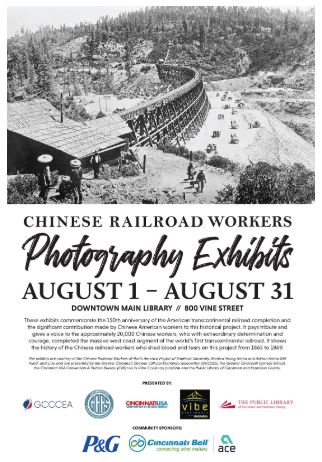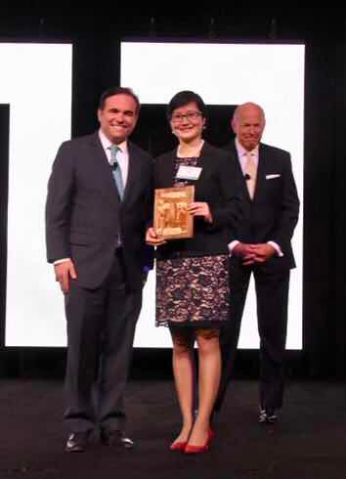
编者按: 辛辛那提市民陶晴(Felicity
Tao)女士服务的辛城中华文化交流协会(GCCCEA)和其他社区及主流社会机构最近两个月一直致力于把两套铁路华工图片展览带到辛辛那提。功夫不负有心人,美国铁路华工图片展将于2019年8月1日至31日在辛辛那提市中心图书馆正式展出,展览对公众免费开放,是一个具有极强的历史和教育意义的展览。这是她为图书馆网站写的博客,阐述了她为什么要把这个展览搬到辛辛那提,以及这个展览为什么对公众如此重要(英文)。

My Journey to Claim American Citizenship
By Felicity Tao
Bringing the Chinese Railroad Workers Photography Exhibits to Cincinnati is
part of my journey to claim American citizenship.
An immigrant from China, I became an American citizen three years ago. Growing
up, I never thought of immigrating to another country. I completed my college
education in China and decided to pursue graduate studies in the U. S. because
American universities were known for their academic excellence and the country
was perceived as a beacon for freedom and democracy. The Chinese of my
generation admired the U.S. as a country exemplary of diversity, tolerance,
justice, and prosperity. It’s known to attract talents from all over the
world, and I was eager to embrace that experience.
My husband came to study Asian American history at University of Cincinnati at
the same time. Through his study, I was exposed to a fuller picture of Chinese
American history, a history full of challenges, injustice, and triumphs.
However, I read it as someone else’s history back then until my personal
journey connected me directly to our predecessors’ painful struggle to claim
American citizenship.

(Ms. Tao was presented the Wendell P. Dabney Award for Diversity by Mayor of
Cincinnati in February 2019)
For generations, there has been this deep sorrow in the Chinese American
community that no matter how hard we try, we are viewed as permanent aliens
because of our appearance and cultural heritage. That sorrow couldn’t be felt
more poignantly than the experience of the Chinese railroad workers who helped
build the iconic, life-altering Transcontinental Railroad.
The completion of the Transcontinental Railroad in 1869 marked a profound
transformation, shortening a dangerous journey of months to a week and
changing the economic, cultural, and geographical landscape of the country.
Between 1865 and 1869, more than 12,000 Chinese workers, who made up 90
percent of the Central Pacific line workforce, toiled at a grueling pace in
precarious working conditions to construct America’s first Transcontinental
Railroad. They were hired because of a labor shortage, and they were
constantly brought in as a strike breaker. When they stroke because of poor
working conditions and lower wages, their employer cut off their food and
supplies until they went back to work. Hundreds died.
However, most of these Chinese workers were all but invisible at the
completion ceremony, and in its retelling for many years afterward. They were
not recognized, but openly discriminated against, vilified, and forgotten. The
1875 Page Act banned Chinese women from immigrating to the United States.
Building upon that, the Chinese Exclusion Act in 1882 prohibited all
immigration of Chinese laborers. It’s the first law implemented to prevent all
members of a specific ethnic or national group from immigrating, and it wasn’t
completely ended until 1965.
It’s no longer someone else’s history I can ignore. I still believe that the
United States is a great country I decided to immigrate to, but I also
couldn’t deny its struggles. I was told not to speak Chinese on a bus when I
was an international student 20 years ago. I was told to go back to China
around my apartment building near UC’s campus. Last year, my husband and I
celebrated our 20th anniversary in San Francisco, the first city we set our
feet on in this country. We were walking on the street, looking for our hotel
around Union Square when someone kicked my suitcase and hurled, “Bitch, hurry
up! Bitch, go back to your country!”
Yes, many progresses have been made since the Chinese railroad workers’ time.
No, some things haven’t changed. I am in a sense a direct descendant from the
railroad workers.
I met Monica Arima, the primary sponsor of the exhibits, at a support rally
for Sherry Chen a couple of years ago. Sherry is an award-winning scientist at
the National Weather Service whose work saved lives and properties. She was
falsely accused of being a spy by her boss largely because of her Chinese
origin. She fought hard to clear her name and won the case against the
Department of Commerce, but had her career and life destroyed in this process.
Monica has a personal drive to tell minority histories to the general public
because she believes we are equal Americans and our history should be
remembered and told like anyone else’s in this country.
The descendants of the Chinese railroad workers worked tirelessly to correct
the record of this part of American history. On May 10th, 1869, the leaders of
the Central Pacific and Union Pacific Railroads came together to celebrate the
joining of the tracks, and Leland Stanford, the business tycoon and political
leader who founded Stanford University, drove a ceremonial golden spike into a
tie to unite them. This spring at the Golden Spike Festival marking the 150th
anniversary of the Transcontinental Rail completion, the Chinese railroad
workers’ descendants attended the re-enactment of this iconic moment in
American history. Most importantly, they took the positions where their
ancestors should have stood and recreated that famous photograph taken at the
completion of the Transcontinental Railroad, the one with no Chinese face.
My son, Teddy, who rides with me every morning this summer to work as an
intern downtown, was in the car with earbuds on when I heard the Golden Spike
Festival story on NPR. I burst into silent tears when I heard one of the
Chinese railroad workers’ descendants, Raymond Chong say: “Chinese were the
perpetual foreigner, and we still are the perpetual foreigner.” I didn’t want
Teddy to hear this. If he heard this, I would tell him this was not true.
America is his home, his homeland. He can grow roots here and have equal
opportunities to thrive. Every nation and every people have their struggles,
and this is one of ours. We don’t have an option but to work hard to make it a
little easier for future generations.
I hope the Chinese Railroad Workers Exhibits helps give a voice to the Chinese
migrants whose labor on the Transcontinental Railroad made a big difference in
this country and to the Chinese community that continues to contribute and
struggles to be equal citizens. I will encourage everyone in this region to
take advantage of this opportunity to learn about our collective history and
experience.

【编者按】 本文仅代表作者观点,不代表APAPA
Ohio及OCAA官方立场。所有图片均由作者提供或来自网络。如存在版权问题,请与我们联系。更多精彩文章,请查看我们公众号的主页。欢迎大家积极投稿!